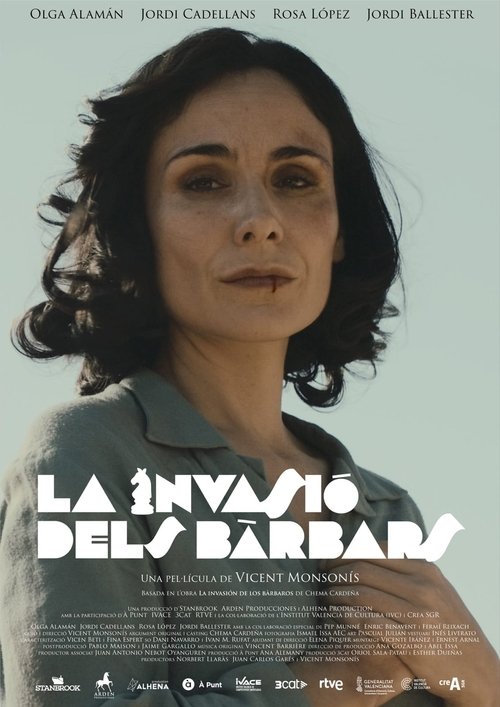
Ask Your Own Question
What is the plot?
Sorry, we aren't able to watch and write up a full detailed plot yet. Check back in a few days.
What is the ending?
Short, Simple Narrative of the Ending:
In the final scenes of La invasió dels bàrbars, the granddaughter of the Prado Museum restorer uncovers the truth about her grandfather's disappearance during the Francoist repression. She finds his remains in a mass grave and, with the help of memorialist associations, gives him a proper burial. The film ends with her standing at his grave, finally able to honor his memory and close a painful chapter in her family's history.
Expanded Narrative Description of the Ending:
The film's climax unfolds in the present day, as the granddaughter, Anna, arrives at the site of a recently excavated mass grave in Valencia. She has spent years searching for the truth about her grandfather, a restorer at the Prado Museum who vanished in 1939 after being questioned about the disappearance of a painting during the early days of Franco's regime. Anna's journey has been driven by a need to understand her family's past and to reclaim the dignity of those silenced by history.
Anna stands at the edge of the excavation site, watching as archaeologists carefully uncover the remains. The atmosphere is solemn, the air thick with the weight of decades of silence and loss. She is accompanied by members of a memorialist association, people who have dedicated their lives to recovering the stories of the disappeared. Their presence underscores the collective nature of this act--this is not just Anna's story, but the story of many families across Spain.
As the remains are identified, Anna is handed a small box containing her grandfather's personal effects--a watch, a notebook, and a fragment of the painting he was accused of hiding. The discovery is both heartbreaking and cathartic. She kneels beside the grave, touching the earth where her grandfather was buried anonymously for over eighty years. The camera lingers on her face, capturing the mix of grief, relief, and quiet resolve.
In a parallel scene, the film briefly returns to 1939, showing the grandfather's final moments. He is interrogated by a colonel, accused of aiding Republicans by hiding a painting that symbolizes resistance. He refuses to betray his principles, and the scene ends with him being led away, never to be seen again. This memory is not shown as a flashback, but as a silent tableau, emphasizing the brutality and injustice of the repression.
Back in the present, Anna attends a small ceremony at the cemetery. The remains are reburied with dignity, and a plaque is placed to honor her grandfather and the others who suffered in silence. The memorialist association members share stories of their own families, creating a sense of community and shared purpose. Anna listens, her earlier isolation replaced by a sense of belonging.
The film's final shot is of Anna standing alone at the grave, placing a single flower on the stone. The camera slowly pulls back, showing the cemetery stretching out behind her, a landscape of memory and loss. The sound of wind and distant birds fills the silence, a reminder that history is never truly buried.
Fate of the Main Characters:
- Anna (the granddaughter): She finds closure by uncovering the truth about her grandfather and giving him a proper burial. Her journey ends with her standing at his grave, finally able to honor his memory.
- The grandfather (restorer at the Prado): His remains are discovered and reburied with dignity. His story is reclaimed, and his sacrifice is acknowledged.
- Memorialist association members: They continue their work, supporting families like Anna's and ensuring that the stories of the disappeared are not forgotten.
Key Points the Movie Makes:
- The film emphasizes the importance of memory and the need to confront the past to heal the present.
- It highlights the collective nature of historical trauma and the power of community in the pursuit of justice.
- The story underscores the dignity of those who suffered under repression and the ongoing struggle to reclaim their stories.
Is there a post-credit scene?
There is no post-credit scene in the 2025 film La invasió dels bàrbars. The film concludes with the emotional resolution of the granddaughter's search for her grandfather's remains, set against the backdrop of historical memory and the lingering impact of the Spanish Civil War. The final scenes focus on her confronting the past, visiting the mass grave, and reflecting on the legacy of loss and silence. No additional scenes or teases appear after the credits roll.
What is the significance of the missing painting in the story of La invasió dels bàrbars?
The missing painting is central to the plot set in 1939, where Esperanza, a young art conservator at the Prado Museum, is interrogated by a Francoist lieutenant because a fascist colonel wants to confiscate this painting. The painting symbolizes cultural heritage and the oppressive control exerted by the regime during that period.
Who is Esperanza and what role does she play in the film?
Esperanza is a young art conservator at the Prado Museum in 1939. She is a key character who is interrogated about the missing painting sought by a fascist colonel. Her experience reflects the repression and cultural struggles during the post-civil war era in Spain.
How does the story connect the events of 1939 with the present day?
The film unfolds across two time periods: the immediate aftermath of the civil war in 1939 and the present day. In the present, Esperanza's granddaughter, Aurora, seeks to uncover the truth and reclaim the legacy connected to the missing painting and the historical injustices faced by her family, linking past trauma with contemporary memory and justice efforts.
What is the role of Aurora in the narrative?
Aurora is Esperanza's granddaughter who, 80 years later, is determined to open the investigation into the missing painting and the historical events surrounding her grandmother. Her quest represents the ongoing fight for memory and justice in contemporary Spain.
How does the film depict the historical repression after the Spanish Civil War?
The film portrays the harsh repression following the civil war through scenes of interrogation, the confiscation of cultural artifacts like the painting, and the broader atmosphere of fear and control by Francoist forces. It also shows the struggle of victims' families in the present day to reclaim their history and the remains of their loved ones from anonymous graves, emphasizing the long-lasting impact of that repression.
Is this family friendly?
La invasió dels bàrbars (2025) is not considered family friendly. The film is a historical drama set in 1939, dealing with themes of war, political repression, and personal loss, which may be disturbing for children or sensitive viewers. There are scenes depicting interrogation, emotional distress, and tension related to the aftermath of conflict, as well as moments of anxiety and fear experienced by the characters. While there is no graphic violence or explicit content, the atmosphere is somber and intense, with some scenes that could be unsettling for younger audiences or those sensitive to historical trauma and emotional drama.






























